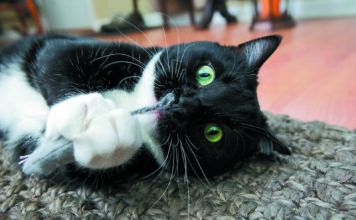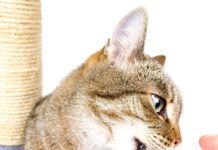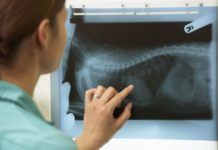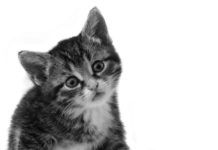Does Your Cat Have Bad Breath?
Yuck! Hairballs!
My Cat is Naturally Lazy. It’s the Breed.
Myth: My cat is just naturally lazy. It's the breed.
Truth: There is no question that there are "fast cats" and "slow cats," just as some people naturally prefer a sprint to a leisurely park stroll. In the animal world Olympics, cats are sprinters, not marathoners. There's a natural tendency to assume that just because your cat doesn't move much, he doesn't like to move at all.
If your cat is seriously overweight, he may have become less active to compensate for his extra pounds. He may even be unable to jump, and both his heart and his lungs are working overtime. He may not be lazy so much as suffering under the strain.
Ask The Doctor – A Chronic Weeping Eye
Q I have a cat that has a problem with a weeping eye (at the nose), a condition she has had for several years.
Now, the iris is gradually turning orange, starting at the nose, and the eye is starting to squint slightly. This seems to be getting worse. When the cat was adopted at about nine months old, she already had this condition (she was microchipped, but we received no response from her owner).
Our veterinarian has tried several different medications to no avail. Do you have any advice?
Sean Mahoney
Help for Feline Dental Disease
In a clinical trial led by Dr. Boaz Arzi - a dental surgeon and researcher with the UC Davis School of Veterinary Medicine - about 20 cats are receiving stem cell therapy that is showing promising results in the treatment of feline chronic gingivostomatitis (or FCGS).
This condition is a debilitating feline dental disease that is marked by severe and chronic inflammation of a cats gums and mucosa, the tissue that lines its oral cavity. Though the disease is relatively uncommon, it is very painful and frequently diagnosed among cats with certain viral diseases - especially feline immunodeficiency virus (FIV).
The Usefulness of X-Rays for Cats
Diagnosis: Feline Leukemia
Chronic Rhinosinusitus in Cats
Overview of Diarrhea Treatments
[From Tufts January 2012 Issue]
Diarrhea is one of the most common health problems seen in cats and can present a diagnostic and treatment challenge because of its wide variety of possible causes. Infectious diseases, toxins, dietary changes and even emotional upset can result in diarrhea, and determining the cause is often a process of elimination.
The most likely causes of diarrhea in a given cat depend on his age and lifestyle, says Michael Stone, DVM, DACVIM, an internal medicine specialist and clinical assistant professor at Cummings School of Veterinary Medicine at Tufts University. Intestinal parasites such as roundworms typically cause diarrhea in kittens. …
Why Do Cats Throw Up So Much?
How Many Vaccines Does My Cat Really Need?
(Think Like a Cat#6) Cat Problems with Hair Balls
Due to the backward-facing barbs on the cat's tongue, the hair he grooms must be swallowed. Some of this swallowed hair passes through the digestive system without a problem. If he swallows too much hair, the cat may vomit up a tubular-shaped glob of wet hair know to those of us who end uup stepping on them as hair balls. Not all hair balls get vomited up or passed with the stool, though. Some swallowed hair ends up trapped in the intestines, causing a blockage.









